Page 102 of 198
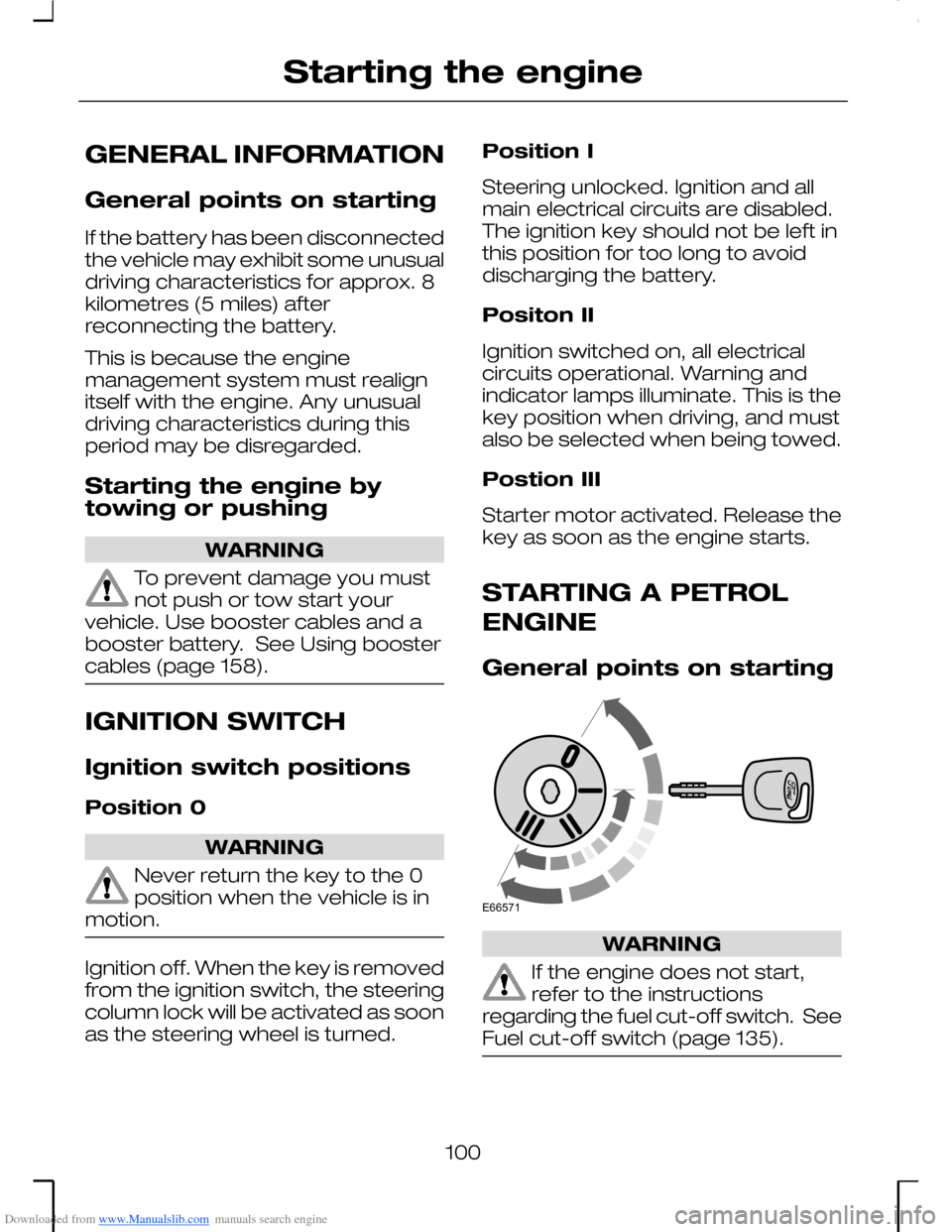
Downloaded from www.Manualslib.com manuals search engine GENERAL INFORMATION
General points on starting
If the battery has been disconnectedthe vehicle may exhibit some unusualdriving characteristics for approx. 8kilometres (5 miles) afterreconnecting the battery.
This is because the enginemanagement system must realignitself with the engine. Any unusualdriving characteristics during thisperiod may be disregarded.
Starting the engine bytowing or pushing
WARNING
To prevent damage you mustnot push or tow start yourvehicle. Use booster cables and abooster battery. See Using boostercables (page 158).
IGNITION SWITCH
Ignition switch positions
Position 0
WARNING
Never return the key to the 0position when the vehicle is inmotion.
Ignition off. When the key is removedfrom the ignition switch, the steeringcolumn lock will be activated as soonas the steering wheel is turned.
Position I
Steering unlocked. Ignition and allmain electrical circuits are disabled.The ignition key should not be left inthis position for too long to avoiddischarging the battery.
Positon II
Ignition switched on, all electricalcircuits operational. Warning andindicator lamps illuminate. This is thekey position when driving, and mustalso be selected when being towed.
Postion III
Starter motor activated. Release thekey as soon as the engine starts.
STARTING A PETROL
ENGINE
General points on starting
WARNING
If the engine does not start,refer to the instructionsregarding the fuel cut-off switch. SeeFuel cut-off switch (page 135).
100
Starting the engineE66571
Page 105 of 198
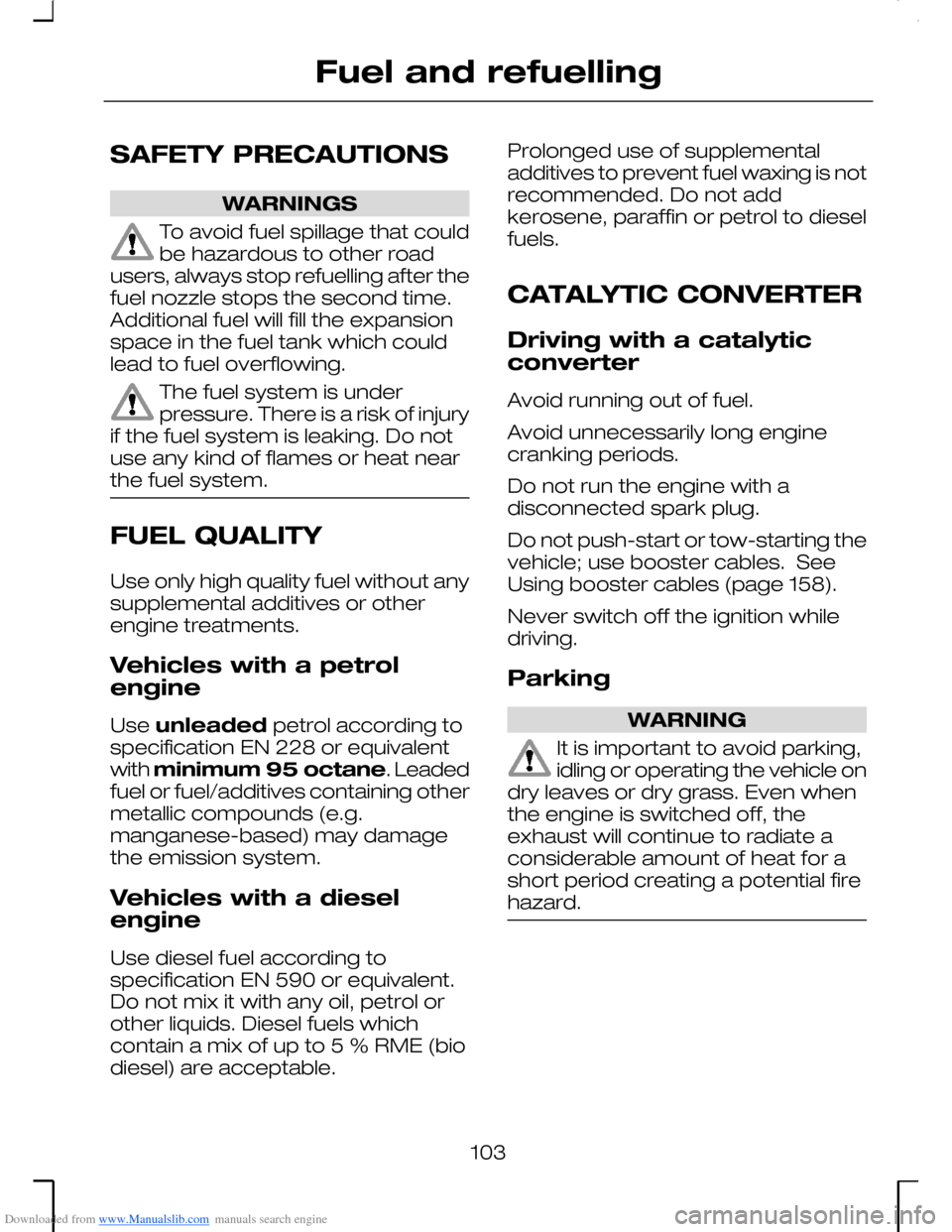
Downloaded from www.Manualslib.com manuals search engine SAFETY PRECAUTIONS
WARNINGS
To avoid fuel spillage that couldbe hazardous to other roadusers, always stop refuelling after thefuel nozzle stops the second time.Additional fuel will fill the expansionspace in the fuel tank which couldlead to fuel overflowing.
The fuel system is underpressure. There is a risk of injuryif the fuel system is leaking. Do notuse any kind of flames or heat nearthe fuel system.
FUEL QUALITY
Use only high quality fuel without anysupplemental additives or otherengine treatments.
Vehicles with a petrolengine
Use unleaded petrol according tospecification EN 228 or equivalentwith minimum 95 octane. Leadedfuel or fuel/additives containing othermetallic compounds (e.g.manganese-based) may damagethe emission system.
Vehicles with a dieselengine
Use diesel fuel according tospecification EN 590 or equivalent.Do not mix it with any oil, petrol orother liquids. Diesel fuels whichcontain a mix of up to 5 % RME (biodiesel) are acceptable.
Prolonged use of supplementaladditives to prevent fuel waxing is notrecommended. Do not addkerosene, paraffin or petrol to dieselfuels.
CATALYTIC CONVERTER
Driving with a catalyticconverter
Avoid running out of fuel.
Avoid unnecessarily long enginecranking periods.
Do not run the engine with adisconnected spark plug.
Do not push-start or tow-starting thevehicle; use booster cables. SeeUsing booster cables (page 158).
Never switch off the ignition whiledriving.
Parking
WARNING
It is important to avoid parking,idling or operating the vehicle ondry leaves or dry grass. Even whenthe engine is switched off, theexhaust will continue to radiate aconsiderable amount of heat for ashort period creating a potential firehazard.
103
Fuel and refuelling
Page 111 of 198
Downloaded from www.Manualslib.com manuals search engine MANUAL TRANSMISSION
WARNINGS
Engage reverse gear only whenthe vehicle is stationary.
Do not apply any undue lateralforce to the gear lever whenchanging from 5th to 4th gear as thiscould lead to the inadvertentselection of 2nd gear.
To avoid shifting noises whenengaging the reverse gear, waitapproximately three seconds withthe clutch depressed when thevehicle is stationary.
Vehicles with 1.8 l Duratec-SCi enginereach the maximum speed only infifth gear.
Reverse gear − 5-speedtransmission
To select the reverse gear, shift thelever into the neutral position andthen press the lever fully to the rightagainst a spring pressure, beforepulling rearwards.
Reverse gear − 6-speedtransmission
1.Lift the locking ring.
2.Move the gear lever towards theleft and forwards.
109
TransmissionE72455 E72456
Page 119 of 198
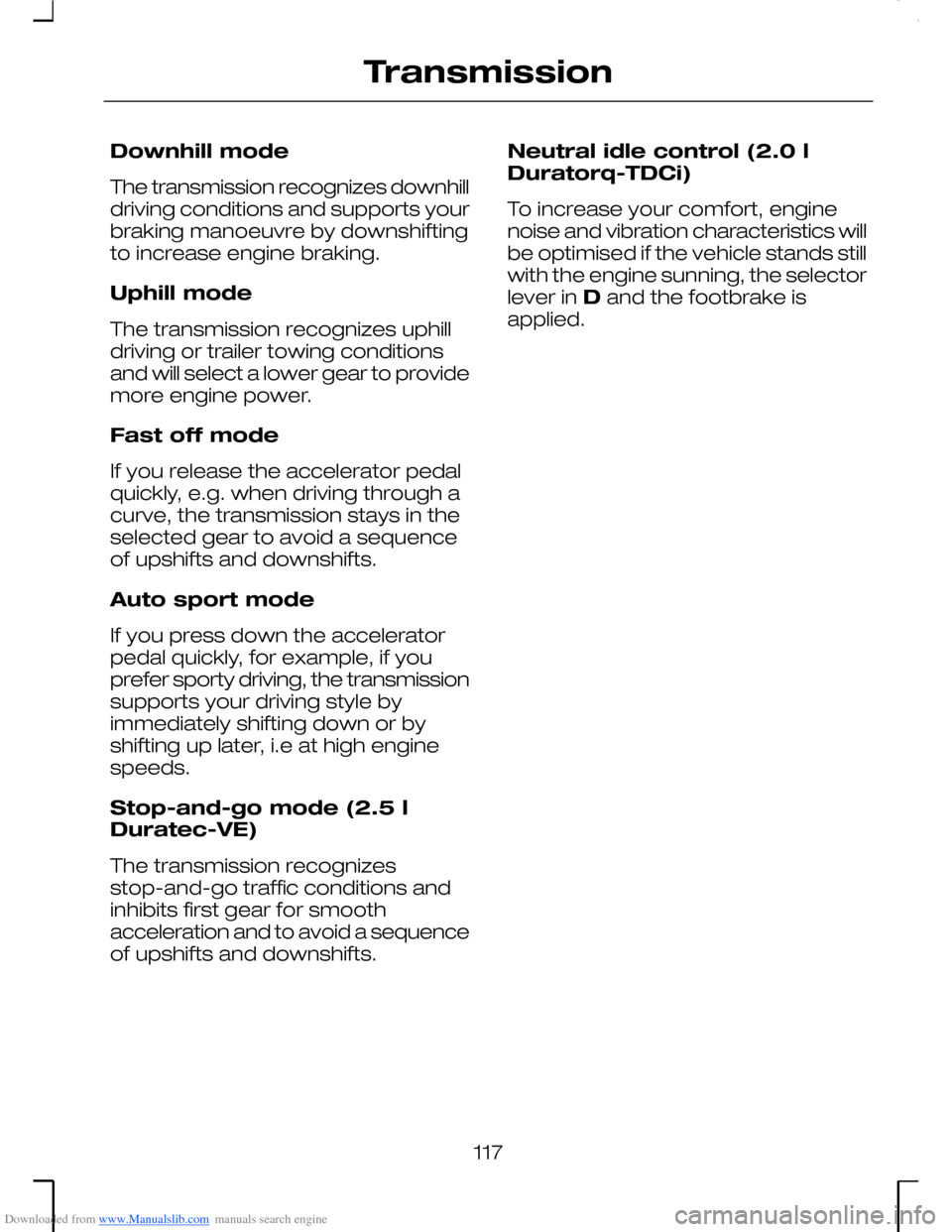
Downloaded from www.Manualslib.com manuals search engine Downhill mode
The transmission recognizes downhilldriving conditions and supports yourbraking manoeuvre by downshiftingto increase engine braking.
Uphill mode
The transmission recognizes uphilldriving or trailer towing conditionsand will select a lower gear to providemore engine power.
Fast off mode
If you release the accelerator pedalquickly, e.g. when driving through acurve, the transmission stays in theselected gear to avoid a sequenceof upshifts and downshifts.
Auto sport mode
If you press down the acceleratorpedal quickly, for example, if youprefer sporty driving, the transmissionsupports your driving style byimmediately shifting down or byshifting up later, i.e at high enginespeeds.
Stop-and-go mode (2.5 lDuratec-VE)
The transmission recognizesstop-and-go traffic conditions andinhibits first gear for smoothacceleration and to avoid a sequenceof upshifts and downshifts.
Neutral idle control (2.0 lDuratorq-TDCi)
To increase your comfort, enginenoise and vibration characteristics willbe optimised if the vehicle stands stillwith the engine sunning, the selectorlever in D and the footbrake isapplied.
117
Transmission
Page 121 of 198
Downloaded from www.Manualslib.com manuals search engine The ABS operates only when thewheels are about to lock. Itsoperation is indicated by a pulsing ofthe brake pedal and full steeringcontrol is retained. Do not releasethe pedal whilst braking.
PARKING BRAKE
All vehicles
WARNING
Vehicles with an automatictransmission should always beleft with the selector lever in positionP.
•Press the foot brake pedal firmly.
•Pull the parking brake lever upsmartly to its fullest extent.
•Do not press the release buttonwhile pulling the lever up.
•If your vehicle is parked on a hilland facing uphill, select first gearand turn the steering wheel awayfrom the kerb.
•If your vehicle is parked on a hilland facing downhill, select reversegear and turn the steering wheeltowards the kerb.
To release the parking brake, pressthe brake pedal firmly, pull the leverup slightly, depress the releasebutton and push the lever down.
119
BrakesE66566 E70430
Page 125 of 198
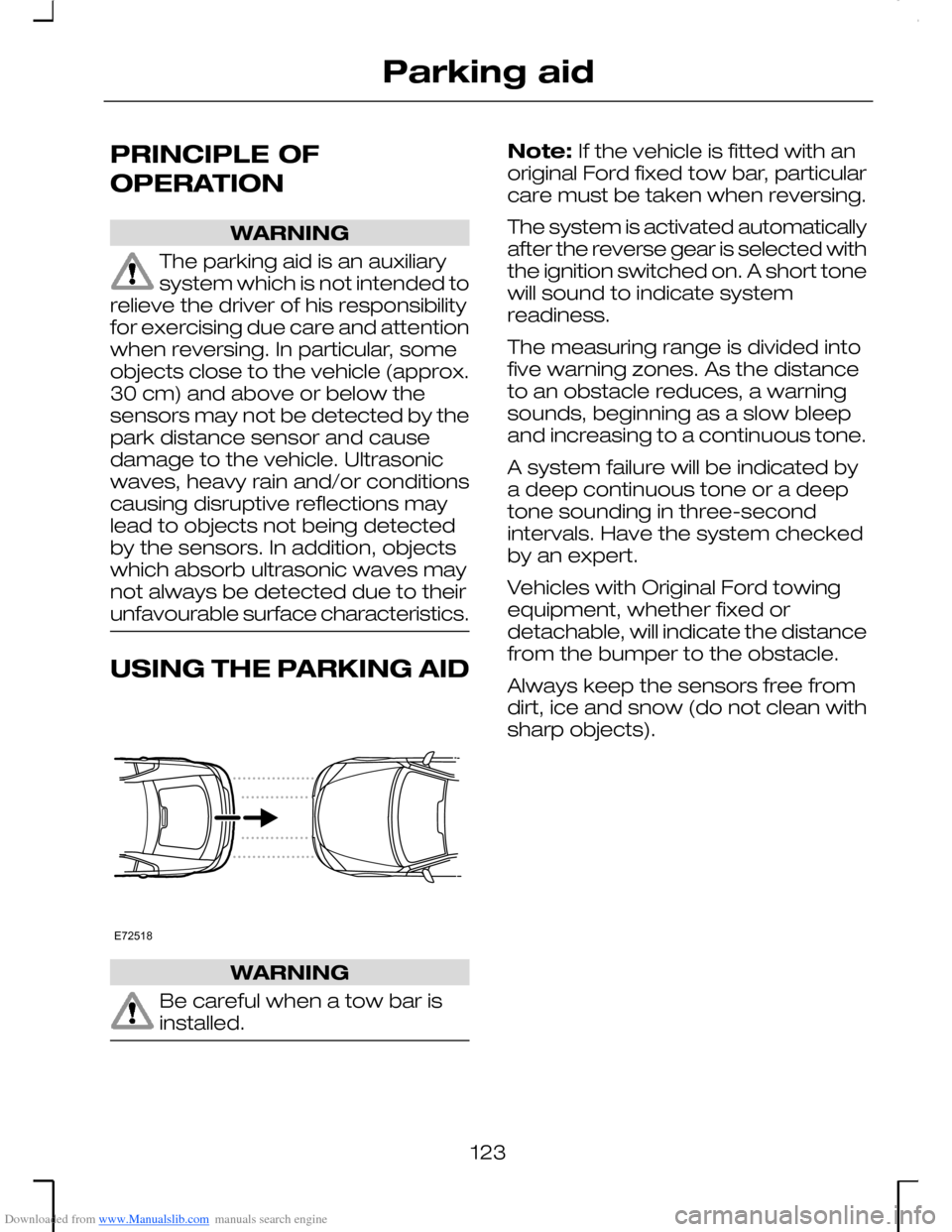
Downloaded from www.Manualslib.com manuals search engine PRINCIPLE OF
OPERATION
WARNING
The parking aid is an auxiliarysystem which is not intended torelieve the driver of his responsibilityfor exercising due care and attentionwhen reversing. In particular, someobjects close to the vehicle (approx.30 cm) and above or below thesensors may not be detected by thepark distance sensor and causedamage to the vehicle. Ultrasonicwaves, heavy rain and/or conditionscausing disruptive reflections maylead to objects not being detectedby the sensors. In addition, objectswhich absorb ultrasonic waves maynot always be detected due to theirunfavourable surface characteristics.
USING THE PARKING AID
WARNING
Be careful when a tow bar isinstalled.
Note: If the vehicle is fitted with anoriginal Ford fixed tow bar, particularcare must be taken when reversing.
The system is activated automaticallyafter the reverse gear is selected withthe ignition switched on. A short tonewill sound to indicate systemreadiness.
The measuring range is divided intofive warning zones. As the distanceto an obstacle reduces, a warningsounds, beginning as a slow bleepand increasing to a continuous tone.
A system failure will be indicated bya deep continuous tone or a deeptone sounding in three-secondintervals. Have the system checkedby an expert.
Vehicles with Original Ford towingequipment, whether fixed ordetachable, will indicate the distancefrom the bumper to the obstacle.
Always keep the sensors free fromdirt, ice and snow (do not clean withsharp objects).
123
Parking aidE72518
Page 131 of 198
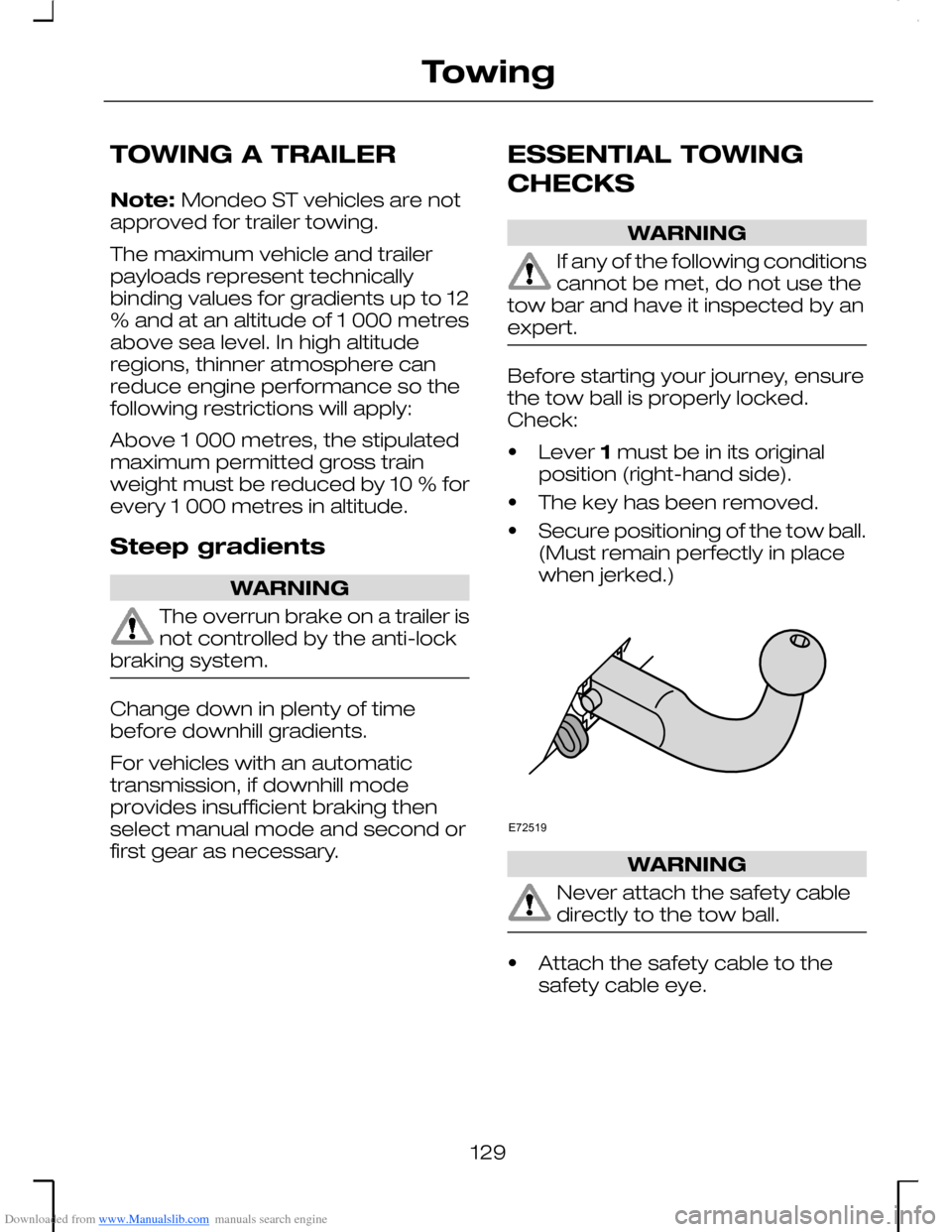
Downloaded from www.Manualslib.com manuals search engine TOWING A TRAILER
Note: Mondeo ST vehicles are notapproved for trailer towing.
The maximum vehicle and trailerpayloads represent technicallybinding values for gradients up to 12% and at an altitude of 1 000 metresabove sea level. In high altituderegions, thinner atmosphere canreduce engine performance so thefollowing restrictions will apply:
Above 1 000 metres, the stipulatedmaximum permitted gross trainweight must be reduced by 10 % forevery 1 000 metres in altitude.
Steep gradients
WARNING
The overrun brake on a trailer isnot controlled by the anti-lockbraking system.
Change down in plenty of timebefore downhill gradients.
For vehicles with an automatictransmission, if downhill modeprovides insufficient braking thenselect manual mode and second orfirst gear as necessary.
ESSENTIAL TOWING
CHECKS
WARNING
If any of the following conditionscannot be met, do not use thetow bar and have it inspected by anexpert.
Before starting your journey, ensurethe tow ball is properly locked.Check:
•Lever 1 must be in its originalposition (right-hand side).
•The key has been removed.
•Secure positioning of the tow ball.(Must remain perfectly in placewhen jerked.)
WARNING
Never attach the safety cabledirectly to the tow ball.
•Attach the safety cable to thesafety cable eye.
129
TowingE72519
Page 132 of 198
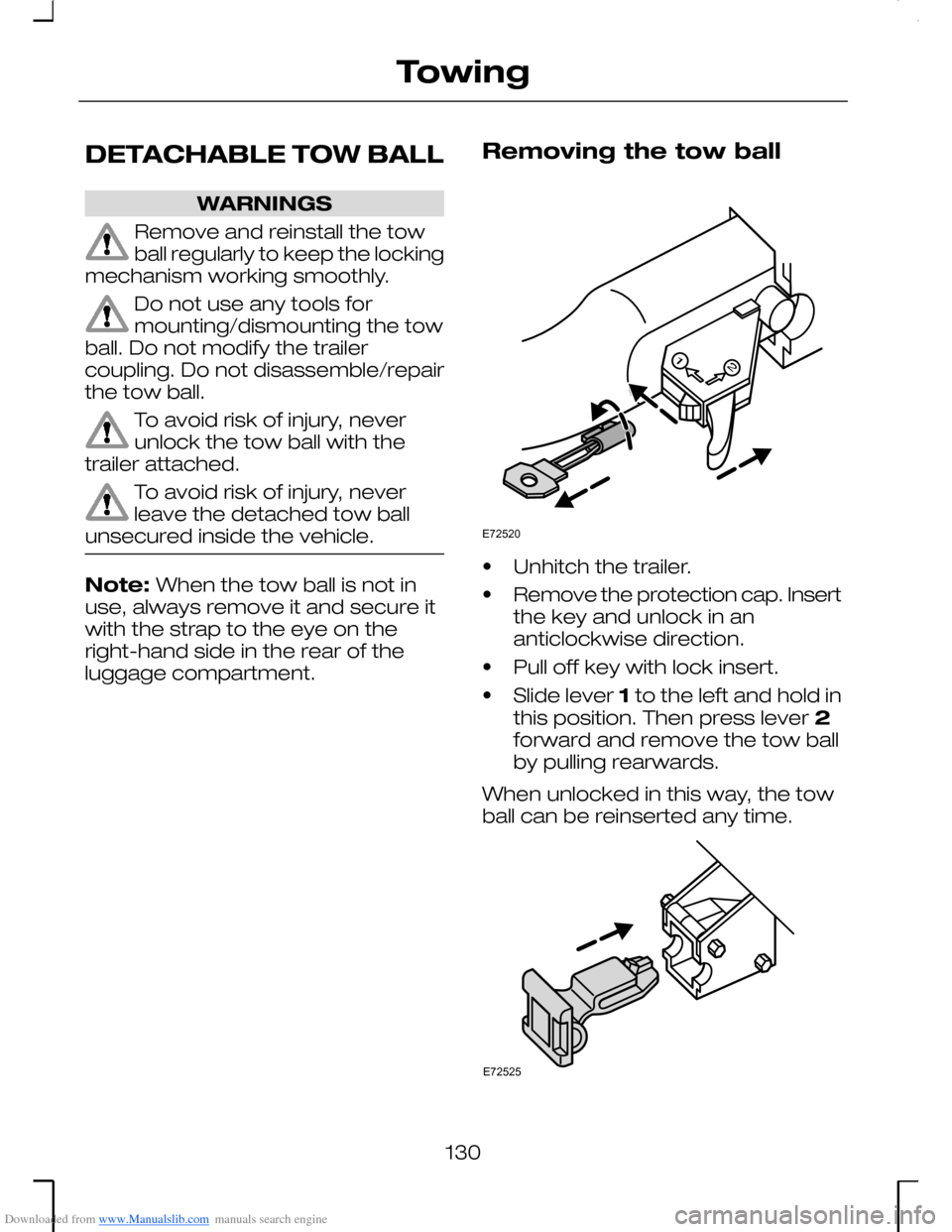
Downloaded from www.Manualslib.com manuals search engine DETACHABLE TOW BALL
WARNINGS
Remove and reinstall the towball regularly to keep the lockingmechanism working smoothly.
Do not use any tools formounting/dismounting the towball. Do not modify the trailercoupling. Do not disassemble/repairthe tow ball.
To avoid risk of injury, neverunlock the tow ball with thetrailer attached.
To avoid risk of injury, neverleave the detached tow ballunsecured inside the vehicle.
Note: When the tow ball is not inuse, always remove it and secure itwith the strap to the eye on theright-hand side in the rear of theluggage compartment.
Removing the tow ball
•Unhitch the trailer.
•Remove the protection cap. Insertthe key and unlock in ananticlockwise direction.
•Pull off key with lock insert.
•Slide lever 1 to the left and hold inthis position. Then press lever 2forward and remove the tow ballby pulling rearwards.
When unlocked in this way, the towball can be reinserted any time.
130
TowingE72520 E72525